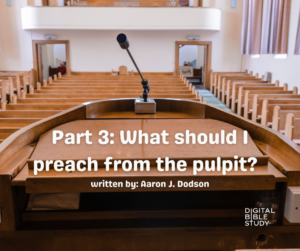Most debates are lost before they begin. In nearly all contests of ideas whoever defines the terms wins the argument. For all my life, it has been the cultural progressive activists that have controlled the language of our society. There has been an unrelenting shift toward language that is more tolerant of sinful and illegal actions. Abortion is couched as “pro choice.” Illegal aliens are now “undocumented workers.” Even pedophiles are being normalized as “minor attracted people.” Whoever controls the language wins. Cultural progressive activists have had a long winning streak.
Since at least the 1980’s, churches of Christ have been navigating our own progressive movement. Just as in our culture, our language in the church has shifted in the direction favored by the activists among us. What used to be established doctrine, we called traditions, and then legalism. What worked in the world has worked in the church. Whoever controls the language wins.
However, in our culture an awakening is slowly taking hold. The cultural activists have pushed the language to the limits of its pliability. They have gone so far that even elite intellectuals among them cannot answer the easiest of questions, “What is a woman?”
I first heard the question about two years ago from the commentator Steve Deace. In recent months we have seen members of Congress use the question to great effect in hearings. We have also seen Matt Walsh’s excellent documentary on the same issue. The question is powerful because it reclaims control of the language. For gender theory to have any viability it needs both fluidity and ambiguity in the definition of words. If we grant that to them, we accept their premise and lose the debate. Yet, the straightforward task of demanding of the activists a fixed definition of a “woman” exposes the logical and moral fallacy of their position.
The lesson that we should take from such a simple question is that it is often the case that the best way to counter an argument is to make sure that we reject the premise of those who are trying to craft the narrative in the first place. Words have meaning and those meanings have consequences. To win the debate, we must control the language.
This lesson needs to be learned by those of us in the church. We need to reject the premise of those seeking to change the church of Christ from within. We must do a better job in managing the use of words we employ to explain biblical matters. The adage “Use Bible words in Bible ways and call Bible things by Bible names” should have new life among us. Progressives have successfully shifted our language. We have ceded ground to them they do not own. Their efforts have created enough ambiguity and fluidity around the nature of the church that many no longer believe in the concept of a non-denominational church of Christ. The surest path back is to reclaim the language. The definition of the “church” is as fixed as the definition of a “woman.” Progressives have spent half a century educating us on what the church is not. That is not enough. They have an obligation not just to declare the doctrines and practices which are non-essential, but also what is essential.
So, what is the church?”
The Tactics of the Cultural Progressives
To understand how the question “What is the church?” can help the church to expose the agenda of progressives within it, all we need to do is to examine the tactics of the cultural progressives. Their tactics are not hidden and are amazingly similar to the efforts of religious activists. Our culture is being torn down first by a denial of objective truth, and then secondly, through the elevation of subjectivism.
Deny the Objective
The cultural progressives start by denying the objectivity of gender identity. For all human history every living person knew what constituted a man and a woman. The first statement made about every new baby born in the world was either “It’s a boy,” or “It’s a girl!” This knowledge was universal – crossing all geographical, cultural, and religious boundaries. Until the cultural activists floated the idea that sex and gender are not related, no one even considered another possibility. Once they changed the language, suddenly there were 57 genders with new ones being discovered daily. They succeeded in destroying the certainty of a known truth. In its place, they inserted an undefined and unfalsifiable subjective reality.
Elevate the Subjective
The second step of the cultural progressives is to assert the superiority of subjectivity over previously accepted objective norms. Their assault on objective gender standards normalized the thought that to determine gender one could not simply note the biological features of a person. It was then a small step to convince our culture that one’s identity is based on how one feels. A rapidly growing portion of our society now believes that subjective and transitory feeling is the sole, true determinant factor in gender. That makes choice of one’s gender wholly personal and unassailable. A person is sovereign in his own identity. Gender is chosen by preference and never assigned. The subjective truth of each person is now sacrosanct.
Objectivity about gender is not only impossible but believing in objectivity is also oppressive violence. To the gender activists and their followers once a person proclaims a gender identity, it is immoral and a sign of hate to question the legitimacy of that identity.
The Tactics of the Religious Progressives
The religious progressives use the same two-step approach in transforming religious groups, even the church of Christ.
Deny the Objective
The progressive infiltration of churches of Christ started with the denial of objective hermeneutics. They sought to erode trust in the standard interpretive practices that had thrived inside of churches of Christ. A hermeneutic that relied on “command, example, and implication” was to them was only a method of interpretation introduced by men like Alexander Campbell who were influenced by Zwingli and Bacon. It was a product of its time. They argued a “Christ-centered” approach was what was needed. He is the pattern and beyond Him no pattern exists. John Mark Hicks summarizes this view well:
The problem is the location of the pattern. The pattern is not found in an implied blueprint in Acts and the Epistles. Paul does not call people to obedience based on a blueprint located in the practices of the church. Instead, he calls them to obedience based on the pattern manifested in the incarnation, life, death, resurrection, and exaltation of Jesus. This is the gospel we obey—the story of Jesus—rather than a blueprint we have inferred from the text but is not explicitly there (https://johnmarkhicks.com/2020/01/21/hermeneutics-is-always-inferential/).
Beyond matters relating to the person of Jesus, there is no objective pattern. It is a all a product of subjective inference.
At first, they claimed that the Restoration Movement was incomplete or still progressing in returning the church to Jesus. That is still part of their claim today. The restoration of the church is only possible through endless progression:
The movement, however, has a serious flaw: it implies that the ideal church is back there [emp – original] somewhere. Christians even speak of becoming “the first century Church” . . . Anytime we tell ourselves that the ideal church, nation, world, or whatever is back there [emp – original] somewhere, we are basically admitting defeat, that back there is as good as it will ever get . . . To say that we need to go back to the first century is admitting defeat. The gospel is still alive and well, and it is taking us somewhere. In Revelation 22:2, John wrote that the leaves of the tree of life were for the healing of the nations. Does the world still need healing today? Obviously, right? So, our best bet isn’t going back there [emp – original] but pressing forward! We must follow the trajectory set by Jesus. (Daniel Rogers, https://labornotinvain.com/2021/02/12/the-problem-with-the-restoration-movement/)
However, as their position denies the basis of the restoration ideal, their new “Christ-centered,” hermeneutical approach asserted the only conclusion that was ever envisioned – there never was a pattern. Since no pattern beyond the person of Jesus ever existed, it would be impossible to restore that which was never intended to exist – a homogeneous church unified not just on Jesus but also on a universal norm of doctrine and practice. A pattern less church could never be identified through the application of any objective, universal trait.
To highlight what they claimed to be the folly of restorationism, they began to ask which of the flawed New Testament churches would we like to restore. Rubel Shelly was among the earliest progressives to express this idea:
It is a “mistaken assumption” that we should “restore the church of the 1st century.” The model we are to pattern after is Christ, not the New Testament church. Those are two different models. The pictures of the church recorded in the New Testament are “only flawed attempts” to follow Christ” (cited in Behold the Pattern, Goebel Music, 283-322).
Again Shelly states:
Which church do you want to restore? Jerusalem, with its lack of evangelistic zeal? Or restore Corinth with its open fornication and, and drunkenness in church services around communion time? What about Colossae with its heresy? What about Ephesus? What about Laodicea, that church that says, “We’ve go it?” And he said you’re dead as a hammer and don’t know it. They said, “We don’t need anything” and He said, “You need everything” (Music, 296).
And on and on they went highlighting non-conforming elements of each New Testament church. By highlighting the multiplicity and diversity of problems in the 1st century congregations, they sought to show that the New Testament church was never unified. It was not and was never intended to be a homogeneous body with common doctrines and practices. In establishing that premise, they claimed to have invalidated the principal of restorationism. Just like the modern cultural progressive, progressives inside churches of Christ began their assault on longstanding norms by the denying the existence of those norms in the first place.
Elevate the Subjective
The religious progressives’ second step mimics those in our culture as well. Since traditional hermeneutics no longer apply and the objective, distinctive marks of the church cannot be used to determine the identity of that church, another standard must be employed. Their new Christ-centered hermeneutic guides our thinking. Just as it is with gender studies where one’s claim is enough to settle gender identity, the basis of recognizing faithful churches boils down to the simple profession of their identity. To many progressives, little more than that confession of faith in Jesus matters in determining congregational faithfulness. Since no authoritative, objective biblical pattern exists, who are we to judge the profession of another’s faith? The only validation of faith that is needed resides in the person making the claim. The reality of faith is wholly subjective.
Progressives have well-fortified subjectivism’s supremacy. To question any person’s claim of faith is prima facia evidence of the intolerance of the querist’s heart. Only a judgmental, legalistic Pharisee would dare to challenge another person’s faith. Once that belief is established, there can be no successful assault on subjectivism.
The Wrong Response of the Cultural Conservatives
For most of my lifetime, conservatives in our culture have been on the defensive in this battle. Cultural progressives have successfully branded the opponents of their agenda with all of the “ist” and “phobe” labels they can create. Cultural conservatives are labeled as racist, homophobes, bigots, and litany of other pejoratives. The natural impulse is to respond by denying the accusations. The conservatives reply by providing evidence to the counter each charge. They are immediately on the defensive in the fight.
The bigger problem is that in the defense there is an inherent acknowledgement of the premise of the allegation. Simply by answering the charge, the conservatives allow the progressives to shift the debate from the initial claim to a discussion about the morality of their opponents. When conservatives respond by saying that they do not hate trans-gender identifying people, they are no longer having a debate about the legitimacy of the concept of gender identity. The discussion is now about their own personal integrity. The debate is now subjective. Just where the progressives want it. The reason is simple. The progressives have already established in the culture that even questioning another’s personal claim of identity is hate. Denying the charge of bigotry only serves to establish that the charge is true.
The Wrong Response of the Religious Conservatives
Conservatives inside churches of Christ have had the same reaction to the charges of our errors. We have denied our alleged legalism. We show examples of our writings and sermons on grace and love. Sometimes we even join sides with the progressives and highlight the radicalism of brethren to “our right.” We do most anything we can to avoid the claims made against us. In doing so, we have made the same mistake that the cultural conservatives have made. We have accepted the premise of our opponents. In seeking to deny the claim there is an implicit acceptance of the validity of the premise leveled against us.
At the commencement of our defense, we have the same style of labeling applied to us as the gender studies theorists now apply to their cultural opponents. Each time when we stand up and proclaim the essentiality for properly organized congregations, properly conducted worship, or any number of other distinctive features of churches of Christ, we are branded. To suggest that a church’s bringing in instrumental music or appointing female elders is a violation of biblical standards and therefore sinful is evidence enough. In the minds of many progressives, there is no other conclusion than to state that we are legalists and lack the love of Christ toward our brethren.
A Better Response of the Cultural Conservatives
To return to the question “What is a woman,” its power is that it is an implicit denial of the premise of the gender activists. The gender activists deny that there is any objective standard to womanhood but then asserts that no one can deny a person’s claimed womanhood. But if womanhood’s identity cannot be denied, then it cannot be defined. If there are no marks of womanhood that are exclusive to it, how can it be distinguished from manhood? It therefore becomes a meaningless term. The activists know this to be true. They understand that in the moment they provide an answer their entire premise on gender identity would collapse. You have noticed they never actually answer the question?
Yet, denying the uniqueness of womanhood does not produce the desired gender inclusivity. It produces a dystopia of gender nihilism. By professing a tolerant, enlightenment that exalts all who claim the title of “woman,” the cultural activists have destroyed the idea and ideal of womanhood. They have lowered womanhood to be within the reach of the vilest claim of the worst degenerate.
A Better Response of the Religious Conservatives
An analogous false premise exists in the doctrine of progressives inside churches of Christ. It is that similar failing which I believe gives the same power to our question, “What is a church?” By denying every element of the New Testament pattern for the church, progressives have denied the existence of the very thing that they claim to be – Jesus’ church. A church that is not definable through its inherent traits is not distinguishable from any other church. If a church cannot become sinful from the wrong acts that it takes, how then does one define its holiness? How can a church ever be right if no objective wrong exists? How can it ever sin if there is no law that it must follow? Remove the idea of an objective pattern and the word “church” becomes a meaningless term.
Denying that the church of Christ has any essential, unique traits distinguishing it from other religious groups does not produce the desired religious inclusivity. It creates religious nihilism. By professing a tolerant, enlightenment that accepts all professions of faith, the religious progressives have lowered the name of Christian to be within the reach of the vilest claim of the worst degenerate.
So, What is the Church?
Every religious progressive has a responsibility to answer this question. As conservatives, we have provided an answer. I believe we have done well at it. We have declared what we believe the Bible reveals about the church. In the text, we found the three-fold work of the church, the five acts of worship, and the pattern of its organization under elders and with deacons. We limited ourselves to calling the church by the designations found in the text. We have recognized the concept of male spiritual leadership among our leaders and preachers. All of these we found in the text and have preached each as an essential item in building churches of which the Lord approves. We have met the obligation of the question. Many may not like our answer, but we have given it.
The progressives have not and cannot. Each item above, progressives have denied as essential. Some deny that the points above are even truth at all. So then, what is essential? Is there even one thing necessary for a church to be acceptable to Jesus? Beyond professing faith in Him, what else is there? Does a church’s worship matter? Is how it is organized something that Jesus demands? Can it appoint women to any role it desires? Progressives are skilled in identifying every trait that is non-essential to the church’s identity. Their obligation is to divulge what is essential to be a church that is faithfully following Jesus. So, please tell us what those essential traits are. However, when you do, be careful that you do not create a pattern that all who identify as faithful must follow. That would be hateful.
So, what is the church?

Jonathan Jenkins
Jonathan is the co-founder of Digital Bible Study. He currently preaches at the Rockledge church of Christ.

Are We Speaking Where the Bible Speaks? Part 1
There is an important question that needs to be addressed, and that question is “Are we speaking where the Bible speaks?”

Part 3: What Should I preach from the pulpit
Dear preacher, don’t allow others to prevent you from teaching the whole counsel of God!

Speak where the bible speaks part 2
Are we speaking where the Bible speaks? We answer this question by looking at additional illustrations of not speaking where the Bible speaks, and we acknowledge the intention of speaking where the Bible speaks.

